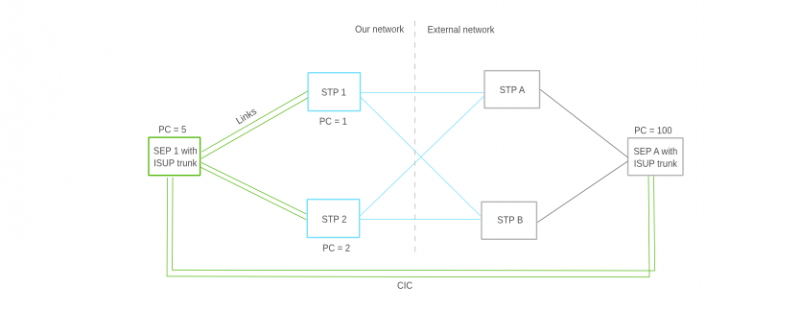Terminology for Yate implementation of SS7
From Yate Documentation
(Difference between revisions)
(Created page with "The purpose of this page is to provide a glossary of terms used throughout this documentation to avoid misinterpretation of terms. Bellow is a typical example of a SS7 networ...") |
|||
| Line 64: | Line 64: | ||
'''Other documentation''' | '''Other documentation''' | ||
| − | Please see the [[Introduction]] and [[ | + | Please see the [[Introduction]] and [[How_To's#SS7_Setups | Usage Scenarios]]. Look at [[Configuring_SS7_components_in_Yate_and_third_party_Products|Configuration]] to see how to define linksets, links and ISUP trunks. |
Also take a look at the following external links: | Also take a look at the following external links: | ||
Revision as of 17:22, 13 November 2017
The purpose of this page is to provide a glossary of terms used throughout this documentation to avoid misinterpretation of terms.
Bellow is a typical example of a SS7 network. The schema focuses on the SEP 1 node and presents the elements from that point of view.
Glossary of terms
- Circuit Identification Code (CIC)
- A number used to identify each circuit in a trunk. Each ISUP message has a CIC field that indicates whose circuit or group of circuits it belongs.
- Destination Point Code (DPC)
- A Point Code that is the destination of a specific Message Signaling Unit
- Global Title (GT)
- A kind of address that has a meaning outside the local network and protocol, for example a phone number
- Global Title Translation (GTT)
- The process of resolving a Global Title to a local network address and possibly protocol
- Link
- A single connection between two SS7 signaling points, it is defined by the Point Codes of the ends of the link and the Signaling Link Code
- Linkset
- A set of links that connect two SS7 signaling points, it is defined by the Point Codes of the ends of the linkset. Each link in a linkset must have a different SLC.
- Message Signaling Unit (MSU)
- The basic data exchange unit in SS7 networks (a SS7 packet of data)
- Message Transfer Part (MTP)
- The set of SS7 protocol layers that deliver Message Signaling Units from one node to another
- Originating Point Code (OPC)
- A Point Code that is the source of a specific Message Signaling Unit
- Point Code (PC)
- A number that represents the address of a SS7 signaling node
- Restart Procedure
- A procedure executed by the MTP of a SS7 node to detect the availability of routes to known nodes
- Route Set
- A set of one or more linksets that are acceptable destinations for a specific Destination Point Code
- Routing Label
- A standard part of a Message Signaling Unit that indicates the DPC, OPS and SLS of that packet
- Signaling Link Code (SLC)
- A number used to identify individual links in a linkset
- Signaling Link Selection (SLS)
- A number used to identify the link on which a SS7 message should be sent over
- Signaling Node (SN,SP)
- An uniquely identifiable (having its own Point Code) SS7 resource
- Signaling Endpoint (SEP)
- A SS7 node that can be a source or destination of non-management messages
- Signaling Transfer Point (STP)
- A SS7 node capable of routing signaling units to other nodes
- Trunk
- A set of voice circuits controlled by ISUP defined by the Point Codes of the exchanges at both ends and a circuit range
Example
Let's assume you are to configure SEP 1 endpoint. To configure it you will have to define the connections to the two STP nodes from our network and the ISUP trunk for sending voice traffic.
According to the above schema we deduce that:
- SEP 1 pointcode: PC=5
- SEP 1 has 2 linksets, each linkset has 2 links.
- linkset1: between SEP 1 and STP 1. So localpointcode = 5 and adjacent pointcode = 1
- linkset1 has 2 links
- linkset2: between SEP 1 and STP 2. So localpointcode = 5 and adjacent pointcode = 2
- linkset2 has 2 links
- linkset1: between SEP 1 and STP 1. So localpointcode = 5 and adjacent pointcode = 1
- SEP 1 ISUP trunk with localpointcode = 5 and defaultpointcode = 100
- When defining the linksets you will also have to mark them as routes for reaching pointcode 100: route=100
Other documentation
Please see the Introduction and Usage Scenarios. Look at Configuration to see how to define linksets, links and ISUP trunks.
Also take a look at the following external links:
